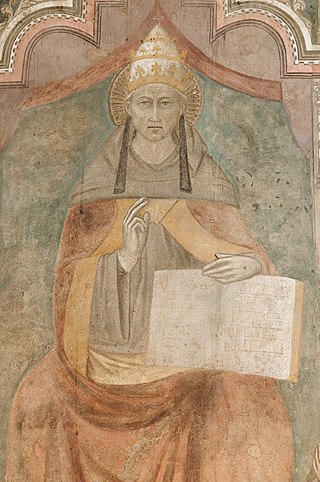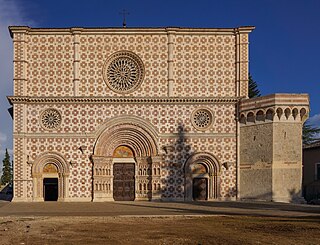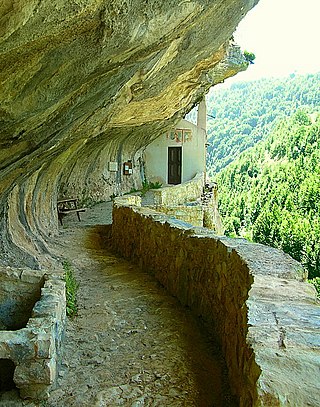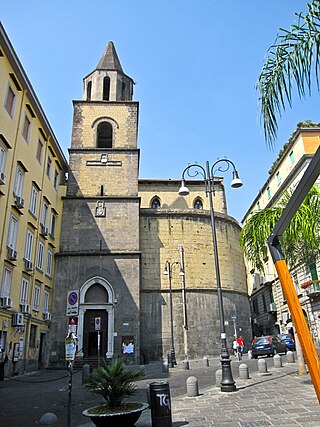
The Celestines were a Roman Catholic monastic order, a branch of the Benedictines, founded in 1244. At the foundation of the new rule, they were called Hermits of St Damiano, or Moronites, and did not assume the appellation of Celestines until after the election of their founder, Peter of Morone, to the Papacy as Celestine V. They used the post-nominal initials O.S.B. Cel. The last house closed in 1785.

Pope Celestine V, born Pietro Angelerio, also known as Pietro da Morrone, Peter of Morrone, and Peter Celestine, was head of the Catholic Church and ruler of the Papal States for five months from 5 July to 13 December 1294, when he resigned. He was also a monk and hermit who founded the order of the Celestines as a branch of the Benedictine order.

Santa Maria di Collemaggio is a large medieval church in L'Aquila, central Italy. It was the site of the original Papal Jubilee, a penitential observation devised by Pope Celestine V, who is buried there. The church, which therefore ranks as a basilica because of its importance in religious history, sits in isolation at the end of a long rectangular sward of grass at the southwest edge of the town.

Roccamorice is a town and comune in the province of Pescara, Abruzzo, central Italy.
Palena is a comune and town in the province of Chieti in the Abruzzo region of Italy.

San Pietro a Majella is a church in Naples, Italy. The term may also refer to the adjacent Naples music conservatory, which occupies the premises of the monastery that used to form a single complex with the church.

Tourism in Abruzzo has become one of the most prosperous sectors in the economy of Abruzzo, and in recent years has seen a remarkable growth attracting numerous tourists from Italy and Europe. According to statistics, in 2021 arrivals totaled 1,330,887. A total of 5,197,765 arrivals were tourists, a figure that puts the region seventeenth among the Italian regions for numbers of tourists per year. A moderate support to tourism is also given to the Abruzzo Airport with many low cost and charter flights connecting the entire region with the rest of Europe.

The Abbey of the Holy Spirit at Morrone, known by various titles, is a former monastery some five kilometers outside of the town of Sulmona, at the base of Monte Morrone, in the Province of L'Aquila, region of Abruzzo, Italy.

The Hermitage of San Venanzio is the site the ancient hermitage of Saint Venantius of Camerino, located above a stream in a remote ravine within a few kilometers north of Raiano, Province of L'Aquila in the Abruzzo, Italy.

Abbazia di San Martino in Valle is a medieval abbey in Fara San Martino, Province of Chieti (Abruzzo).

Eremo di Sant'Angelo is an hermitage located in Lettomanoppello, Province of Pescara.

Eremo di San Bartolomeo in Legio is an hermitage located in Roccamorice, Province of Pescara, in the Abruzzo region of Italy.

Eremo di San Domenico is an hermitage located in Villalago, Province of L'Aquila.

Eremo di San Giovanni all'Orfento is an hermitage located in Caramanico Terme, Province of Pescara.

Eremo della Madonna dell'Altare is an hermitage located in Palena, Province of Chieti.

Eremo della Madonna di Coccia is an hermitage located in Campo di Giove, Province of L'Aquila.

Eremo di San Michele Arcangelo is an hermitage located in Pescocostanzo, Province of L'Aquila.

Eremo di Sant'Onofrio is an hermitage located in Serramonacesca, Province of Pescara.

Eremo di Sant'Onofrio al Morrone is an hermitage located in Sulmona, Province of L'Aquila ., dating back to the thirteenth century. A monk by the name of Pietro Angelerio living at this hermitage later became Pope Celestine V. The hermitage is located at an altitude of 620 meters, and can only be reached via a steep path from the village of Badia, on the eastern edge of the Valle Peligna.

Mount Porrara is a mountain in the Abruzzi Apennines, located between the lower province of L'Aquila and the province of Chieti, a natural geomorphological continuation south of the Maiella, included in the Maiella National Park.





















